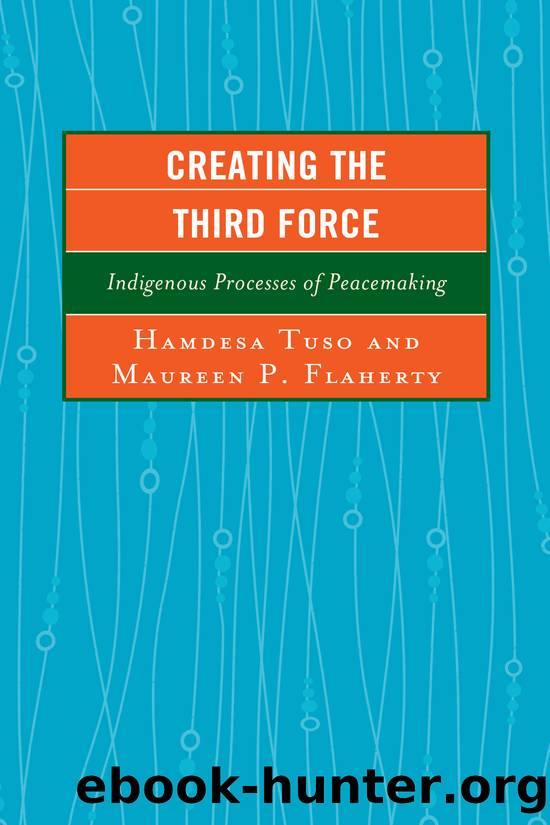Creating the Third Force by unknow

Author:unknow
Language: eng
Format: epub
Publisher: Lexington Books/Fortress Academic
Chapter 13
Indigenous Guard in Cauca, Columbia
Peaceful Resistance in a Region of Conflict
Javier Mignone and Harold Gómez Vargas
The chapter begins by providing the context within which the Indigenous Guard was created by the Consejo Regional IndÃgena del Cauca (CRIC) during the 1990s, as a way of developing a peaceful response to numerous conflicts in the Cauca region, Colombia. The Indigenous Guard operates as a permanent, nonviolent, civil defence organization, with strong youth involvement. At present the Guard has approximately 6,000 active members responsible for protecting communities by preventing the incursion of armed groups from entering into the tribesâ territorial reserves. The chapter will subsequently link the peace activities of the Indigenous Guard with worldviews related to the cultural dimensions of these initiatives. It will analyse their peacemaking approaches in dealing with conflicts as an extension of their worldview. As such, the chapter will provide evidence for and discussion about the role of Indigenous communities in modifying and creating hybrid models of peacemaking. Latin American peace scholars have emphasized how âpeace-building must be rooted within specific socio-historical contexts.â1 The chapter explores these contexts in relation to the creation and function of the Indigenous Guard as an actor of peaceful resistance that encompasses what scholars have identified as three central aspects of civil resistance: mobilization, resilience, and leverage.2
CAUCA
The department3 of Cauca is located in southwestern Colombia, and has a population of 1,269,000,4 of which 190,000 are Indigenous.5 While Indigenous people occupy 20 percent of the land, a white minority (4.5 percent) owns 40 percent of the land.6 Contrary to the general tendency in Colombia, the majority of the population in Cauca lives in the rural area (65 percent). Cauca is a department with little economic growth, and agriculture is the major economic activity, followed by agricultural manufacturing, and commerce. Cauca is one of the regions in Colombia that has been highly impacted by an economic policy of exploiting the vast natural resources of the country, a strategy that has increased in strength over the last 15 years. For instance, African palm oil and gold mining exploitation have dramatically increased.7 Whatever the opinion about these policies, capitalist developments have gone hand in hand with strong militarization and para-militarization, and the displacement of communities, largely by force from areas where economic projects are developed. As Cortes explains, âleftist guerrillas and narco-paramilitary organizations have also established lucrative illegal businesses, like drug production and transportation, in many of these areas.â8 Consequently, these forces, with the addition of common criminal bands, are in a violent struggle to control these legal and illegal businesses. The rural population of Cauca, mostly Indigenous people, peasants, and Afro-Colombians, have been severely affected by this conflict.
There are seven Indigenous ethnic groups in Cauca, namely Nasas, Misak (or Guambianos), Totoroes, Kokonucos, Yanaconas, Eperara-Siapidara, and Ingas,9 although the majority are Nasa. For the most part, they live in 83 Indigenous resguardos. According to articles 63 and 329 of the 1991 Colombian Constitution, a resguardo is land collectively owned by Indigenous communities, and that right is inalienable, imprescriptible, and cannot be garnished.
Download
This site does not store any files on its server. We only index and link to content provided by other sites. Please contact the content providers to delete copyright contents if any and email us, we'll remove relevant links or contents immediately.
| Civil War | Operation Desert Storm |
| Veterans | Vietnam War |
The Radium Girls by Kate Moore(11969)
100 Deadly Skills by Clint Emerson(4876)
Rise and Kill First by Ronen Bergman(4739)
The Templars by Dan Jones(4656)
The Doomsday Machine by Daniel Ellsberg(4447)
The Rape of Nanking by Iris Chang(4165)
Killing England by Bill O'Reilly(3968)
Hitler in Los Angeles by Steven J. Ross(3923)
Stalin by Stephen Kotkin(3917)
12 Strong by Doug Stanton(3525)
Hitler's Monsters by Eric Kurlander(3289)
Blood and Sand by Alex Von Tunzelmann(3164)
The Code Book by Simon Singh(3126)
Darkest Hour by Anthony McCarten(3096)
The Art of War Visualized by Jessica Hagy(2972)
Hitler's Flying Saucers: A Guide to German Flying Discs of the Second World War by Stevens Henry(2730)
Babylon's Ark by Lawrence Anthony(2646)
The Second World Wars by Victor Davis Hanson(2502)
Tobruk by Peter Fitzsimons(2476)
